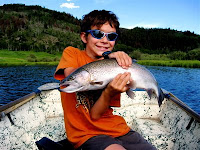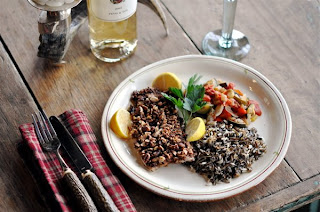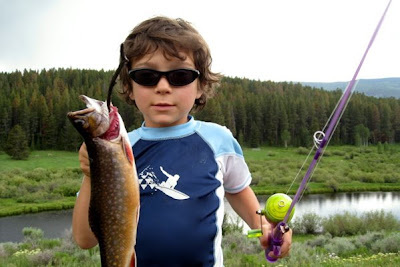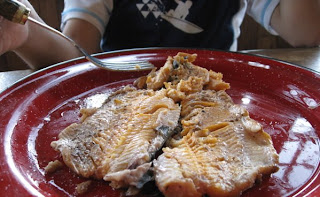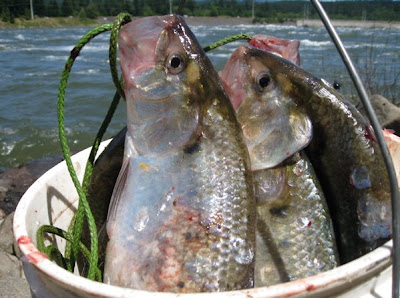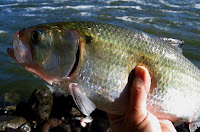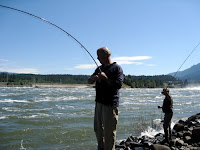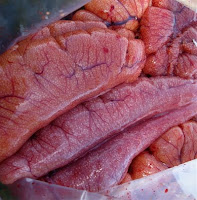
Hardcore flyfishers know about a bug that emerges briefly in late spring, usually when brawling western rivers are running full tilt with runoff. This three-inch bug hatches in prodigious numbers, swarms of them crawling over bankside vegetation, falling in the water, flying hither and thither in their drunken helicopter pilot way—driving both the fish and those who stalk the fish crazy with a quivering, unhinged desire. This bug is called the salmonfly (Pteronarcys californica); it’s a giant stonefly with a salmon-colored underside, and it’s a scrumptious meal for a trout.
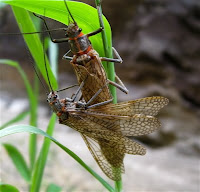 Salmonfly hatches come off on some pretty good rivers: Rock Creek in Montana, the Deschutes in Oregon, and elsewhere. Problem is, oftentimes the rivers are too blown out to fish when the hatch is on. Anglers with time or money (or usually both) might spend years trying to catch a salmonfly hatch at its peak. When conditions are just right—river in fishable condition, flies in big numbers, fish looking up—you need to drop everything and get yer ass on the water. The hatch might be over a day later—moved upriver to private waters, or just gone, poof!
Salmonfly hatches come off on some pretty good rivers: Rock Creek in Montana, the Deschutes in Oregon, and elsewhere. Problem is, oftentimes the rivers are too blown out to fish when the hatch is on. Anglers with time or money (or usually both) might spend years trying to catch a salmonfly hatch at its peak. When conditions are just right—river in fishable condition, flies in big numbers, fish looking up—you need to drop everything and get yer ass on the water. The hatch might be over a day later—moved upriver to private waters, or just gone, poof!
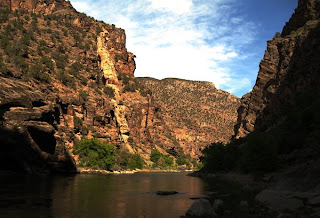 When my friend Warpo and I planned our excursion into Colorado’s Black Canyon of the Gunnison months ago, we weren’t thinking about the salmonfly hatch. Because of tricky scheduling, we would be going in early July, a couple weeks after the hatch in normal years. But this hasn’t been a normal year, and lingering snowpack in the Rockies has delayed all sorts of signs of the season, including wildflower blooms, bird nesting, and…The Hatch.
When my friend Warpo and I planned our excursion into Colorado’s Black Canyon of the Gunnison months ago, we weren’t thinking about the salmonfly hatch. Because of tricky scheduling, we would be going in early July, a couple weeks after the hatch in normal years. But this hasn’t been a normal year, and lingering snowpack in the Rockies has delayed all sorts of signs of the season, including wildflower blooms, bird nesting, and…The Hatch.
The night before leaving for the canyon, we watched a documentary to prime the pump. Twice. The boys over at Felt Soul Media put together a 17-minute award-winning film that captures the beauty of the rugged canyon and the madness of the angling action during the salmonfly emergence. (You can watch it on their web site.) It didn’t make them many friends in some quarters, notably among the locals who were keeping this fishery close to the vest for years. But as with so many priceless natural resources, if folks don’t know, it might just be trashed…by the developers, miners, timber barons, water hogs, and other exploiters. In this case, the threat is from Front Range water users like Denver, always on the lookout for more agua to sprinkle on Kentucky Bluegrass yards in desert suburbia. (It should also be noted that Felt Soul is doing yeoman’s work to expose the greed and fraud of the proposed Pebble Mine in the headwaters of Alaska’s most cherished fishery, Bristol Bay, with their latest film, “Red Gold.”)
The skyrocketing popularity of fly-fishing in the last 20 years and the concurrent pressure on fisheries has resulted in an increasingly technical (some might say fussy) approach to the sport, with ever tinier flies and leaders and warier fish. The salmonfly hatch, on the other hand, is a refreshing trip in the Wayback Machine: big flies, big fish, big scenery. The only indicators of the 21st century are the hordes of absurdly geared-out anglers.
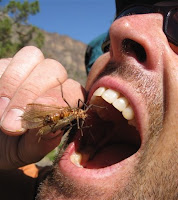 While I’m at it, taking a few shots at modern flyfishing, let me say a few words about the modern “angler” who would never deign to kill a fish. Weak sauce. That’s all I’ll say. If you’re willing to hook fish after fish in the mouth and play them till near exhaustion, you should have the nuts to give at least one a rock shampoo—where legal, of course, and within the limits of a practical conservation ethic—and eat it for dinner. All else is hypocrisy. Warpo and I were looking forward to a trout dinner in the backcountry. When we reached the bottom of the canyon, we were hot, sweaty, and hungry. Warpo’s had a tapeworm for as long as I’ve known him. I told him the fishing might take his mind off his stomach, that we would be eating large that night if successful.
While I’m at it, taking a few shots at modern flyfishing, let me say a few words about the modern “angler” who would never deign to kill a fish. Weak sauce. That’s all I’ll say. If you’re willing to hook fish after fish in the mouth and play them till near exhaustion, you should have the nuts to give at least one a rock shampoo—where legal, of course, and within the limits of a practical conservation ethic—and eat it for dinner. All else is hypocrisy. Warpo and I were looking forward to a trout dinner in the backcountry. When we reached the bottom of the canyon, we were hot, sweaty, and hungry. Warpo’s had a tapeworm for as long as I’ve known him. I told him the fishing might take his mind off his stomach, that we would be eating large that night if successful.
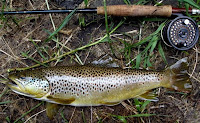 How was the fishin’? Well, friends, let me tell you. The scene did not disappoint. Clouds of salmonflies filled the air. They were everywhere. You couldn’t walk the banks without getting them on you. They crawled up your legs and even into your shorts. Every now and again you’d see some fisherman with a big grin on his face doing a little jig on the rocks, trying to dislodge a few misguided salmonflies from the family jewels. And the fishing was off the hook. The first day we fished 12 hours straight—all on top—without a break. Huge trout crashed our flies with ceaseless abandon.
How was the fishin’? Well, friends, let me tell you. The scene did not disappoint. Clouds of salmonflies filled the air. They were everywhere. You couldn’t walk the banks without getting them on you. They crawled up your legs and even into your shorts. Every now and again you’d see some fisherman with a big grin on his face doing a little jig on the rocks, trying to dislodge a few misguided salmonflies from the family jewels. And the fishing was off the hook. The first day we fished 12 hours straight—all on top—without a break. Huge trout crashed our flies with ceaseless abandon.
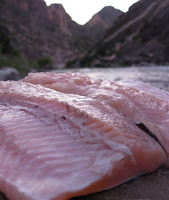 Toward the end of the day I started thinking about dinner. Whirling disease has taken a toll on the Gunnison’s rainbows, but browns are open to harvest. The rules require a brown to be at least 16 inches, so I whacked this one above. He was big enough to fillet, and despite the limited scope of a Leatherman knife, the fillets turned out pretty decent. We had a Ziplock ready with a mixture of breadcrumbs, flour, oregano, Old Bay, and a few other spices lifted from the cabinet before dawn. A little olive oil in the pan and these babies were sizzling as darkness enveloped the canyon.
Toward the end of the day I started thinking about dinner. Whirling disease has taken a toll on the Gunnison’s rainbows, but browns are open to harvest. The rules require a brown to be at least 16 inches, so I whacked this one above. He was big enough to fillet, and despite the limited scope of a Leatherman knife, the fillets turned out pretty decent. We had a Ziplock ready with a mixture of breadcrumbs, flour, oregano, Old Bay, and a few other spices lifted from the cabinet before dawn. A little olive oil in the pan and these babies were sizzling as darkness enveloped the canyon.
Warpo has rekindled his childhood interest in flyfishing only in recent years. We’ve made a few trips together, but he had yet to catch a really big fish, a true hawg. Last year he lost one during a moment of bad decision-making on the part of his net-man. The lost fish stayed with him, haunting his dreams. After our first day of the hatch, he could point to numbers of large fish caught to ease the pain, but not a bragging-rights monster…
Until a few minutes before our departure the next day, when he perfected his “wall artistry,” hooking this brute against a sheer slab of impassable rock at the full extent of his casting abilities. (For perspective, Warpo is a tall fella, with knobby, oversized carpenter’s hands.) The big ‘bow was released to eat more salmonflies and tempt the next lucky angler who braves the depths of the Black Canyon.
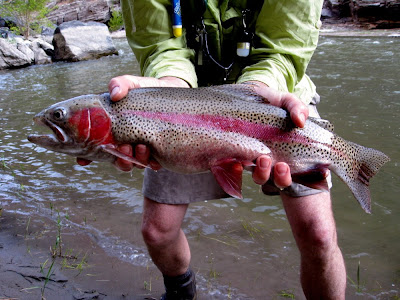
Like this:
Like Loading...
 DESPITE A LONG list of ingredients and a double strain, this is actually a fairly easy soup to make.
DESPITE A LONG list of ingredients and a double strain, this is actually a fairly easy soup to make.




